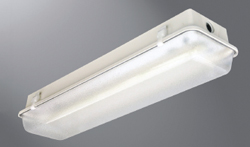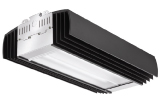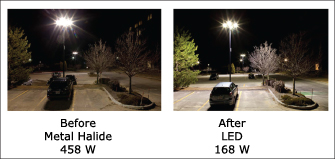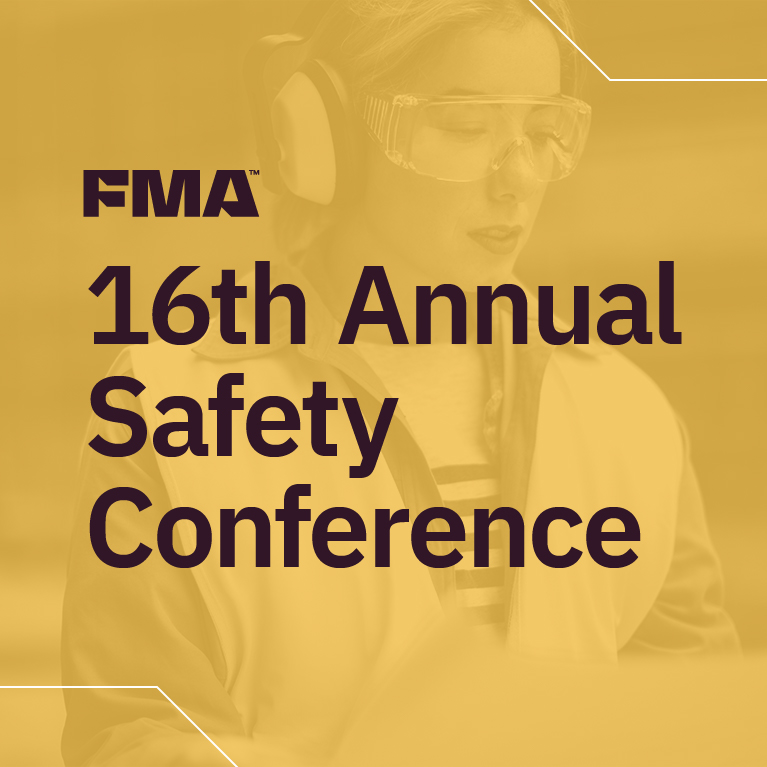Is LED Right for MFG?
By Kate Bachman | March 27, 2012
Category: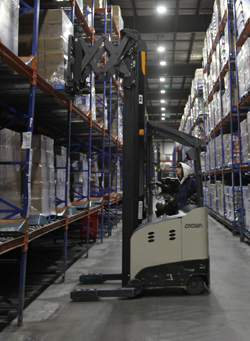
LED lighting has found its way into many high-bay applications in factories and warehouses. Photo of WhiteWave Foods cold storage area by Andrew Shurtoff for Green Manufacturer.
Light-emitting diodes (LEDs) are taking the lighting industry by storm. With energy demand growing and costs rising, manufacturers are looking high and low for energy-saving opportunities, and lighting is the low-hanging fruit.
LED lighting was center stage at last year’s LIGHTFAIR® International expo and is likely to be in the limelight again this year. Its energy efficiency, safety, and light quality are well-documented. It has become the darling of specialty lighting designers for avant-garde commercial buildings. But is it right for use in factories in a lighting retrofit?
A query of a dozen leading lighting manufacturers netted almost as many different viewpoints: “Yes”; “Definitely”; “It depends”; and “Absolutely!” Anytime you ask that many lighting-makers a question, you’re likely to get different answers, especially considering that a manufacturing plant houses myriad spaces—the plant floor, inspection areas, warehouses, offices, docks, parking lots—all with diverse lighting needs.
None of the respondents said, “No, never,” except to qualify that light quality and safety should never be sacrificed in pursuit of lower electricity costs.
Some maintain that LEDs are suitable for many applications in industrial plants but are not ready to replace fluorescent bulbs and high-intensity discharge (HID) lighting, which includes metal halide, high-pressure sodium, and mercury vapor, in high-bay (mounted 20 feet or higher to light a wide area underneath). Others assert that LED is full-on ready for high-bay and production area lighting as well.
One theme, however, was repeated consistently by nearly every manufacturer questioned: LED’s value extends beyond its energy efficiency. Its long life makes it nearly maintenance-free, which emerged almost as highly valued as its energy-conservation qualities.
Everyone agreed that manufacturing plants are great candidates for energy-efficient lighting retrofits in general, and that if a manufacturing plant has not upgraded its lighting in the past 10 years, it is high time for a lighting retrofit.
The 12 lighting manufacturers provided their perspectives on LED technology’s applicability for manufacturing, its role in factories, and what they can realistically expect in terms of an ROI and benefits with an LED retrofit.
1. Is LED lighting applicable for manufacturing plants? Why or why not?
Figure 1
An LED luminaire is especially suitable for cold-storage applications, not only because its cool operation does not add thermal load, as fluorescent and HID lights do, but also because its instant switch on/off capability means that manufacturers do not have to leave lights on when the area is not in use and can outfit them with occupancy sensors. Photo courtesy of Cooper Lighting,
Peachtree, Ga.Michael Schratz, director of marketing, Dialight Corp. Yes!
We have been installing LED high-bay fixtures into manufacturing plants since the end of 2009. To date we have installed more than 60,000 LED high-bays at some of the largest companies in the world.
We are now supplying a version of the same LED high-bay fixture from 2009 at the same wattage (150 W) with almost double the light output (from 8,000 lumens in 2009 to 14,000), delivering 90-plus lumens per watt. This goes to show how far the technology has come in such a short amount of time.
Cheryl Ford, applications marketing manager, Osram Sylvania. It depends.
Depending on the lighting applications and the manufacturing plant’s goals and budget, the investment in LED lighting may be completely justifiable.
High Cost. Although a number of new LED high-bay fixtures were recently introduced for manufacturing and warehouse lighting, it may be difficult to justify the economics because of the high initial cost of the fixtures.
Compared to Fluorescents. LED lighting is the latest technology to join a long line of applicable options—high-efficiency T5, T5HO, and T8 fluorescent lighting systems; electronic ballast ceramic metal halide systems; and induction lighting systems. For high-bay lighting, 6- to 8-lamp T8 or 4- to 6-lamp T5HO fluorescent fixtures with long lives and high-efficiency ballasts may be the best options from an economic standpoint.
Some T8 lamps actually last up to 62,000 hours and some T5HO lamps last up to 60,000 on 12 hours per start, whereas an LED fixture might last only 50,000 hours. Coupling these fluorescent lamps with high-efficiency ballasts nets the lowest energy consumption, saving 2 to 4 watts per fixture over standard T8 or T5HO electronic ballasts.
New Fixtures Needed for LED. Too, when considering upgrading fluorescent lighting systems with LEDs, decision-makers must take into account that new fixtures definitely would be required. However, retrofitting existing T12 or T8 fluorescent systems with newer, energy-saving, longer-life fluorescent lamps and ballast systems would not require new fixtures.
Jim Jantzi, president, New-Form Tools. Yes.
Light Quality. We installed our LED lighting throughout the plant 2 1/2 years ago. It’s been the best thing to brighten the plant long term. Visitors commented on whether we had freshly painted the factory.
Energy Cost Reduction. In addition, the cost of lighting has been reduced by two to 10 times in various departments. In one location, an LED lamp shining on a strategically placed outdoor sign pays for itself through reduced energy costs every 75 days.
Tommy Harris, value stream director, Lithonia Lighting. Yes.
A properly designed LED high-bay luminaire is capable of providing the Illuminating Engineering Society of North America (IES) recommended light levels while withstanding the high ambient temperatures commonly found in manufacturing environments.
Mark Spencer, director of marketing, Lusio. Absolutely.
Energy Efficiency. With our LED high-bay fixtures with up to 103 lumens per watt, a facility can lower its energy usage by as much as 70 percent compared to traditional HID and fluorescent fixtures.
Enhances Control. Energy use can be further curtailed by dimming or turning off fixtures when areas are not occupied. LED fixtures turn on instantly with no ramp-up time.
Bob Smith, PE, director, energy marketing solutions, Cooper Lighting. It depends.
Manufacturing plants’ requirements vary widely, and no single lighting technology offered today is the best solution for all of them. First, it is very important that these applications have adequate and reliable light levels for safety.
High Cost. Although LED luminaires have technological advantages over both the HID and fluorescent luminaires that typically are specified today, they may not provide sufficient energy savings to overcome the higher costs as a mainstay alternative.
However, LED technology’s value is forecast to improve over time as the LED performance advances. The LED improvement road map, updated by the U.S. Department of Energy, shows LED efficacy improving as the cost decreases. As this occurs, LED luminaires will gain broader acceptance and will replace the HID and fluorescent systems.
Les Kaminski, technical sales manager, Waldmann Lighting. Definitely.
Long Life. LED lighting offers many advantages due to its long life. Because there is almost no maintenance, it eliminates service and downtime, allowing for machines to operate without the need for lighting maintenance.
Bob Roller, vice president of lighting, business development, Cree. In general, yes.
The answer is not as straightforward as the question. Up until now HIFs have been the lighting choice for manufacturing facility managers. Advances in LED technology and efficacy, however, make LED lighting a compelling and energy-efficient option for manufacturing. Manufacturers often require the highest-quality lighting, with specific needs ranging from high foot-candle requirements to extremely even lighting. Our LED is suitable for most manufacturing applications.
William Busch, senior product manager, Philips Day-Brite. Yes.
Reduced Total Cost of Ownership. LED luminaires are applicable for manufacturing plants, because they can produce light levels comparable to those of traditional HID and fluorescent light sources with reduced total owning and operating costs. Power consumption is lower, and maintenance costs are reduced due to the longer life of the LEDs.
Rey Roque, vice president of marketing, Pixi Lighting. It depends.
There is such a huge variety of manufacturing plants, from the huge Boeing 747 Everett facility to Dole food processing plants to small-footprint machine shops. Currently our LED luminaires cannot replace fluorescent high-bay applications or even applications that currently use metal halide or sodium lamps. Our LED luminaires (flatlights) are specified for approximately 12 feet maximum, or they can be used for higher ceilings with cabling to lower them.
Joe Martin, vice president and general manager, Precision-Paragon. The short answer is yes…
LED lighting can be a good choice for manufacturing plants, but it’s not always the best choice, or even the most energy-efficient choice. It all depends on the specifics of each manufacturing plant’s needs and the goals of the lighting retrofit.
Fluorescents More Efficient. For the most common type of lighting fixture in a manufacturing facility, high-bay lighting, fluorescent lighting has been the de facto energy-efficient technology for the past 10 years. It is only recently that LED-based high-bays became viable.
While LED lighting is still rapidly evolving, the current generation of LED high-bay fixtures are still a bit less efficient in terms of lumens per watt than the current generation of fluorescent high-bay fixtures.
However, with the right fixture in the right application, LEDs may be as efficient as fluorescent high-bays in terms of lumens per watt.
For example, we make some of the most efficient LED-based fixtures in the business, but generally, efficient LED high-bays produce around 80 lumens of light, but some of the most efficient LED fixtures can deliver nearly as much light as fluorescents at over 90 lumens per watt.
This often surprises people, but it makes sense when you think about the history of the two lighting technologies. While LED lighting technology has rocketed to the forefront over the past few years, fluorescent lighting has been improving in terms of efficiency, aesthetics, and longevity for more than 100 years, with significant increases in the last 10 years.
Because LED is a rapidly advancing technology, and technological advances may let LED-based high-bays eclipse the efficiency of fluorescents in the next few years, many of the LED-based fixtures we manufacture incorporate replaceable LED modules so that our customers have the option of swapping them out to get the benefits of those improvements without replacing the entire fixture.
The initial cost of the fixtures is another area where LED high-bays face a challenge. While end user costs vary widely depending on fixture construction and options, a typical fluorescent high-bay can cost under $150, while an efficient LED high-bay can cost closer to $800.
Ross Barna, CEO, RAB Lighting Inc. Yes.
Longevity. Outdoor LED lighting used for manufacturing facilities beats metal halide performance in terms of quality and quantity of light, price, energy efficiency, and reliability. You can’t find a metal halide wallpack out there with a five-year warranty. You can for LED. Facility managers love the no-maintenance concept, and this stuff is selling like crazy.
2. If LED lighting is applicable for factories, what are its best applications and advantages?
Figure 2
LEDs work well with controls and can be dimmed or connected to occupancy and photocell sensors. Photo courtesy of Lithonia Lighting, Atlanta.Jantzi, New-Form Tools. To Replace Metal Halide, Outdated Fluorescent. The best application with the fastest payback is replacing incandescent, metal halide, and sodium light fixtures. Second is the replacement of outdated fluorescent lighting, which in many jurisdictions requires special arrangements to dispose of the bulbs. LEDs do not require ballasts. This virtually eliminates fire hazards and the environmental impact of disposal.
High, Hard-to-reach Locations. The time needed for electrical staff and contractors to replace lighting can be reduced significantly, giving them more time to focus on other electrical requirements. This is especially important when the lighting is in very high locations and rental equipment [scissor lifts and bucket trucks] is required to reach those locations.
Brightening Effect. The pure white lighting gives more light and a clearer environment for people to work in.
Reduced Power Factor. Plant owners with industrial electrical meters will be interested to know that the power factor of LEDs—a hidden cost savings—generally is 99 percent; fluorescent lamps have a power factor of 55 percent.
Smith, Cooper Lighting. Cold Storage. Presuming the LED luminaire is designed properly to ensure a reliable driver operation, it operates best in cold ambient temperatures and offers high light level operation instantly [see Figure 1]. The most logical manufacturing application would be cold storage, where the high LED efficacy would reduce the thermal load on the cooler. This extends the LED’s lifetime and sustainable light levels, further reducing the maintenance costs.
Harris, Lithonia Lighting. LED high-bay luminaires work great in both manufacturing and warehousing environments.
Controls. LEDs offer instant on/off capability and can be easily dimmed. This allows for the extensive use of occupancy and dimming photocell sensors, which take advantage of periods of inactivity and natural daylight to reduce energy consumption and maximize LED life [see Figure 2].
Ford, Osram Sylvania. The best applications would include task and inspection areas, offices, and outdoor site lighting.
Task. One advantage of LED lighting is the directionality of the light emitted that really focuses the light where it is needed. This feature is particularly beneficial on a production line.
Inspection. Inspection tables that typically use halogen PAR [parabolic aluminized reflector] lamps could be replaced with LED PAR lamps. Premium LED PAR lamps are available with a 95+ color rendering index and a high R9 red component greater than 50. These are best to make sure defects can be seen as they are seen using halogen light.
The comparable LED wattage for a 90-W halogen PAR38 is 21 to 24 W, a savings of up to 77 percent in energy consumption. Rated LED lamp life is typically 25,000 hours, up to 10 times longer than halogen PAR lamps.
Warehouse, Dock. Some LEDs can provide the necessary illumination for loading and unloading materials or finished goods. These save up to 80 percent in energy costs over halogen options and have a long life (L70).
[L70 is the amount of time at which the initial light output has dropped to 70 percent of its original value; average rated life is the time when 50 percent of the lamp has failed.]
Outdoor Site. Last but not least, LED technology is a highly viable option and current trend for outdoor site lighting applications. Parking lot or façade lighting with metal halide or HPS cobra head, shoebox, or wallpack fixtures can be replaced with LED fixtures. The upgrade to LED typically reduces energy usage by 50 to 75 percent, depending on pole height and spacing [see Figure 3]. A properly designed LED fixture can improve lighting uniformity, providing better visibility and a safer environment.
The LED systems last two to three times longer than metal halide, with a rated life of up to 70,000 hours (L70). Noncycling HPS lamps last up to 40,000 hours, but the yellow light does not provide the best-quality lighting for parking lots; white light is better [see Figure 4].
Figure 4
Staples headquarters parking lot in Framingham, Mass., with metal halide lighting (left) and LED. Photo courtesy of Osram Sylvania.Roller, Cree. LED lighting can easily be used in many areas in the plant: offices, storage areas, lobbies, and other relatively low-ceiling-height areas. When it comes to lighting a plant floor, specific attention must be given to required light levels, maintenance considerations, and other conditions.
24/7 Operation. Many factories operate 24 hours per day, from five to seven days per week. LED lighting can save time and money on maintenance over fluorescent systems. For example, on a 30,000-hour-rated fluorescent system, group relamping might be performed on a two-year cycle. LED lighting with a rated life of 50,000 hours requires maintenance one-third as often.
Cold Storage. Refrigerated manufacturing plants or warehouses represent an excellent opportunity for LED. HID systems normally are used in these spaces because the low temperatures have an adverse effect on the performance of fluorescent lighting systems; however, while not affected by the low temperatures, HID lighting adds significant thermal load, which has to be removed to maintain the low temperatures. In typical refrigerated warehouses, if you save $1 in electrical costs from LED’s lower wattage consumption, you’ll save another $0.50 in reduced refrigeration costs.
LEED® Certification. Companies looking to achieve Leadership in Environmental and Energy Design (LEED) certification for their plants or warehouses may find merit in the points given for the energy reductions possible by installing LED lighting.
Kaminski, Waldmann Lighting. Almost all applications.
Wide to Narrow Beam. There are all sorts of LED options available, from spot (narrow beam angle) to flood (wide beam angle), that make them fit all lighting requirements.
Constrained Spaces. Compact design allows them to be engineered for tight-fitting or narrow spaces, which is not possible with other light sources. LEDs can fit into the smallest machines or light the largest areas with great performance.
Vibration Resistance. In addition, LED’s resistance to vibration makes it a superior light source in rugged environments.
Busch, Philips Day-Brite. General Lighting, Aisles. The best applications are for general lighting in manufacturing areas and warehouse aisles [see Figure 5].
Temperature-tolerant. LED luminaires are available for the various ambient temperatures expected in manufacturing environments and offer different degrees of protection against contaminants (IP ratings). It is up to the user to select a luminaire that meets his lighting and environmental requirements.
Figure 6
This lighting fixture example is an alternative to a 400-W metal halide or 6-lamp T5HO fluorescent high-bay and uses 35 to 50 percent less energy and has a longer life. This fixture is typically used for mounting heights of 20 to 40 feet. Photo courtesy of Lusio, Overland Park, Kan.Schratz, Dialight. High-energy-cost Geographic Regions. Manufacturing facilities that best benefit from LED high-bays include those located in areas of the country that are prone to high energy costs.
Hard-to-Reach Spaces. The lights are applicable for facilities that accrue significant maintenance costs while servicing lights (requiring scissor lifts, bucket trucks, and teams of electricians).
Hazardous Locations. Facilities that require hazardous (classified) location ratings on their light fixtures, where safety is their main concern, can benefit from improved quality of light and peace of mind that the lights will function in these rugged environments for a very long time.
Spencer, Lusio. LED’s best applications are the replacement of HID and fluorescent fixtures [see Figure 6].
In general, LED fixtures deliver the best return the fastest in facilities that experience long lights-on periods of more than 15 hours a day, primarily because of the dramatic reduction in energy consumed.
Beyond energy savings, every lighting application has its own specific challenges, from varying foot-candle requirements, automated or manual control requirements, extreme heat or cold, or nonstandard ceiling heights and floor plans. Full-featured LED high-bay product families offer various optics, outputs, control options, color temperatures, and other features to meet the requirements of
most any facility.No Negative Effect on Lamp Life From Repeated Ramping. LEDs can deliver well beyond the L70 lifetime of 70,000 (high output) and 100,000 (standard output) hours with direct interfaces to dimmers and occupancy sensors without negative impact on lamp life. (Traditional fluorescent and HID lighting sources are negatively affected by repeated ramping-on cycles.)
Roque, Pixi Lighting. Color-critical Inspections. LED lighting can be used for task lighting on manufacturing floors in QC inspections. It is ideal for color-critical applications such as quality control inspection for fabrics, woodgrain, and paint finishes. Because LED lighting comes in a variety of color temperatures of white, it can create the best environment for workers and showcase for products during assembly.
Disposal Costs Eliminated. Using LED lighting eliminates the disposal costs associated with fluorescent, metal halide, and HPS lamps [see Figure 7].
Barna, RAB Lighting. Best applications include building perimeter and security lighting, parking lot lighting, sprinkler standpipe indicators, interior task lighting in manufacturing cells, cold-environment lighting (way better than all other alternatives), areas with significant vibration … the list goes on and on.
Martin, Precison-Paragon. Any application that takes advantage of LED lighting’s unique benefits is worth considering.
On/Off Switching. One benefit of LED is its excellent compatibility with automatic switching, especially in cold environments. In food manufacturing facilities with subzero freezer storage, fluorescent fixtures take a few minutes to reach their full brightness. This means that a fluorescent lighting system would have to be turned on at the beginning of a work shift, and left on throughout the entire shift. In contrast, LED-based fixtures reach full brightness instantly, even in extremely cold temperatures.
Therefore, they can be fitted with motion sensors so they come on only when a cold-storage area is occupied. Adding sensors can reduce burn times by 60 percent or more.
LEDs last much longer in cooler temperature. For high-bay high wattage LED applications, caution must be used in ambient temperatures above 75 degrees F.
Good Distribution. Because of LED lighting’s excellent light distribution capabilities, it can be a very good option for situations where a uniform light level is needed over a wide area. This might reduce the wattage needed of each LED fixture to be used compared to equivalent fluorescent fixtures.
Maintenance-free. One advantage of LED-based fixtures is their longer maintenance-free operation times. Depending on the fixture’s configuration and ambient temperature of its environment, an LED-based high-bay could operate without any kind of maintenance two or three times longer than an equivalent fluorescent fixture. If the fixtures are mounted in an inaccessible or hard-to-reach location, that can be an awfully nice benefit.
3. What are realistic expectations for plant owners installing LED lighting in terms of energy consumption and cost?
Jantzi, New-Form Tools. Up to 12 Times Energy Use Reduction. It has been our experience that replacing sodium and metal halide fixtures with LEDs has reduced energy costs by up to 12 times. Incandescent lighting energy costs generally are reduced by six to seven times, and replacing fluorescent with LEDs reduces energy costs by two to three times.
Our LED installation is maintenance-free. We expect this to continue for 20 to 30 years. My expectations have been exceeded in that electrical personnel no longer need to replace fluorescent bulbs with lifespans that are predictably very short.
This is by far the largest energy breakthrough since the incandescent light bulb.
Smith, Cooper Lighting.The answer is complex and depends on the application and the light levels needed.
If the application can take advantage of the optical control characteristics of LEDs, the user may drastically cut the number of LEDs required to provide adequate light levels, which significantly reduces energy consumption.
Cold-storage applications that have ambient temperatures of -30 degrees C would consume less power than the same product installed in 20-degrees-C ambient because of LED’s higher efficiencies stemming from lower forward voltage from the cold temperature. The use of controls would extend the life while reducing energy; however, the installed costs would be higher to deploy the controls. So, the answer is multifaceted.
Roller, Cree. 40 to 75 Percent Energy Reduction. Against incumbent lighting technologies of metal halide, linear fluorescent, and HPS, facility managers can expect to achieve between 40 and 60 percent energy reduction using LED lighting. In a warehouse, even greater savings can be obtained by using occupancy sensors, which can further cut energy consumption in half for a total reduction of 75 percent.
LED lighting can cost more upfront than antiquated lighting technologies—but the ongoing energy savings and maintenance avoidance can quickly recoup these costs and deliver additional savings.
Ford, Osram Sylvania. The LED fixture cost and energy consumption are dependent on the application.
Savings at Two Times Price Point. If the price point of an LED fixture is no more than two times the cost of a traditional lighting fixture typically used, then it may be an economically feasible option.
Ceramic metal halide fixtures with bilevel electronic ballasts are another alternative if a single lamp fixture is preferred, but look for a high-efficiency fixture. In addition, some high-bay fixtures with 200-W ceramic metal halide lamps on electronic ballasts can replace up to a 400-W metal halide fixture. Both the 4-lamp T5HO and single-lamp, 200-W ceramic metal halide fixtures reduce energy consumption by approximately 50 percent compared to a 400-W metal halide fixture.
By taking advantage of utility rebates, users can dramatically reduce the cost to install LED fixtures.
Low Maintenance Helps Bottom Line. The long life of an LED lighting system has additional benefits for the bottom line because less frequent lighting maintenance is needed, minimizing costly manufacturing downtime to replace lamps. This should be factored into the total cost of ownership calculations.
Spencer, Lusio. Low Total Cost of Ownership. When considering a move to LEDs for general illumination, companies should consider several factors in addition to energy savings. These include a long product lifetime; low maintenance requirements; the ability to use occupancy sensors; dimming capabilities; and no heat gain—all of which contribute to an accurate assessment of the cost of ownership of any lighting system.
Kaminski, Waldmann Lighting. Savings in Low or No Maintenance. Although LEDs do realize some energy conservation, the majority of cost savings comes from low or no maintenance, which allows for continuous manufacturing without downtime to fix lighting and associated labor costs.
Busch, Philips Day-Brite. 40 Percent Lower Power Consumption. Each application is different as required light levels vary by the application or task being performed. The commonly used HID luminaire in a manufacturing application, a 400-W probe-start metal halide high-bay, has a power consumption of 460 W. The lamp has an L70 of 8,000 hours and an average rated life of 20,000 hours.
A typical LED high-bay that can produce the same light levels as this 400-W unit has a power consumption of 288 W, an L70 of 100,000 hours, and an average rated life that far exceeds 100,000 hours, because LEDs do not burn out like metal halide lamps do.
This says that the LED option has about a 12 times better maintenance cycle and a 40 percent lower power consumption with virtually unlimited life. The user can expect to pay a much higher cost for an LED luminaire, but will realize a reduced total cost of ownership compared to a traditional metal halide system.
Schratz, Dialight. More Than 60 Percent Savings. Typically, our 150-W LED high bay is replacing 400-W HID fixtures (metal halide, high-pressure sodium) at a one-for-one rate, so energy savings will be more than 60 percent.
The typical upfront cost of an LED high-bay fixture is at least double the cost of a traditional HID fixture. However, we are seeing payback trends of two years or less when the energy and maintenance savings associated with LED-based fixtures are factored in—not to mention all of the state rebates for LED lighting products shorten that payback period even more—on a product that should last up to 10 years.
Roque, Pixi Lighting. 1.5- to 2-year Payback. When you factor in labor and disposal costs and the fact that fluorescent troffers use ballasts with useful lifetimes far shorter than the fluorescent tubes in them, plant owners can see a payback period between 1.5 and 2 years with LED lighting.
Barna, RAB Lighting. 80 Percent Energy Savings. Energy consumption can be reduced over existing systems by up to 80 percent; and the payback on investment is typically four years or less. In some applications, the payback has been less than one year. When utility rebates are available (which they are in many states), the payback can be instantaneous.
Harris, Lithonia Lighting. Many Years’ Trouble-free Operation. LED lighting offers better optical control, which improves the utilization of light on tasks. This is a true case of doing more with less.
The facility operator must understand which LED lumen package and optical distribution provide the required horizontal and vertical light for his or her facility. This can be accomplished with the help of a lighting professional using lighting design software or by conducting a trial installation in the actual space. Also, LED luminaires have much better lumen maintenance than traditional sources such as metal halide (HID). Therefore, it is not required to overlight the area to compensate for the rapid depreciation of light inherent in HID light sources.
When properly designed, an LED high-bay lighting system can save energy, especially when used with occupancy and photocell sensors, and will provide many years of trouble-free operation in a manufacturing or warehousing facility.
Martin, Precision-Paragon. Two- to Five-year Payback. The initial cost of LED-based lighting fixtures is significantly higher than for other technologies, but in the right situations, they’ll pay for themselves in just a few years.
Those interested in LEDs can use a lighting calculator to get a rough estimate of what to expect to save at their facility with any energy-efficient lighting retrofit. In a 500,000-sq.-ft. manufacturing facility running 80 hours a week, they could expect a typical energy-efficient lighting retrofit to cost $440,000 to $660,000, and save $95,000 to $115,000 per year. That means that without any rebates or incentives, the project would pay for itself in about five years.
With LED-based retrofits, that payback period is often a bit longer than other lighting retrofits, but even so, LED-based fixtures will pay for themselves in energy savings long before the fixtures need to be maintained or replaced if deployed properly.
Many areas offer utility rebates and incentives, and in the real world where many of our LED fixtures are placed, they can pay for themselves with energy savings in two to five years.
In Light of…
Several concepts emerge clearly. HID is on its way out. LED is on its way in. LED is a rapidly advancing technology, and its cost is predicted to decrease as its capabilities improve.
The efficiencies and longevity advantages of LED vary depending on what type of lighting manufacturers are currently using and for which applications, and whether they have special considerations such as hard-to-reach locations or cold storage.
Another truth shines clearly. The value of an LED retrofit can extend far beyond the electricity it saves. Evaluation of LED’s applicability should include not only the initial cost, but the total cost of ownership, respondents said.
For instance, how much effort and cost are required to replace bulbs? Does it require renting lift equipment? Hiring specially trained personnel to do it? How much does it cost to disrupt manufacturing operations to change out lighting? How much additional savings can be netted with occupancy and daylight sensors and dimming controls? Is the lighting in a cold area where LED’s cool operation will not compound energy usage? How important is it that no special disposal is required? And how much is all of that worth to you?
Cooper Lighting, www.cooperlighting.com
Cree, www.cree.com
Dialight Corp., www.dialight.com
Lithonia Lighting, www.lithonia.com
Lusio, www/lightwild.com
New-Form Tools, www.newformtools.com
Osram Sylvania, www.sylvania.com
Philips Day-Brite, www.philips.com
Pixi Lighting, www.pixi-lighting.com
Precision-Paragon, www.p-2.com
RAB Lighting Inc., www.rabweb.com
Waldmann Lighting, www.waldmannlighting.com

Side by side, we move metal fabrication forward.
FMA unites thousands of metal fabrication and manufacturing professionals around a common purpose: to shape the future of our industry, and in turn shape the world.
Learn More About FMA